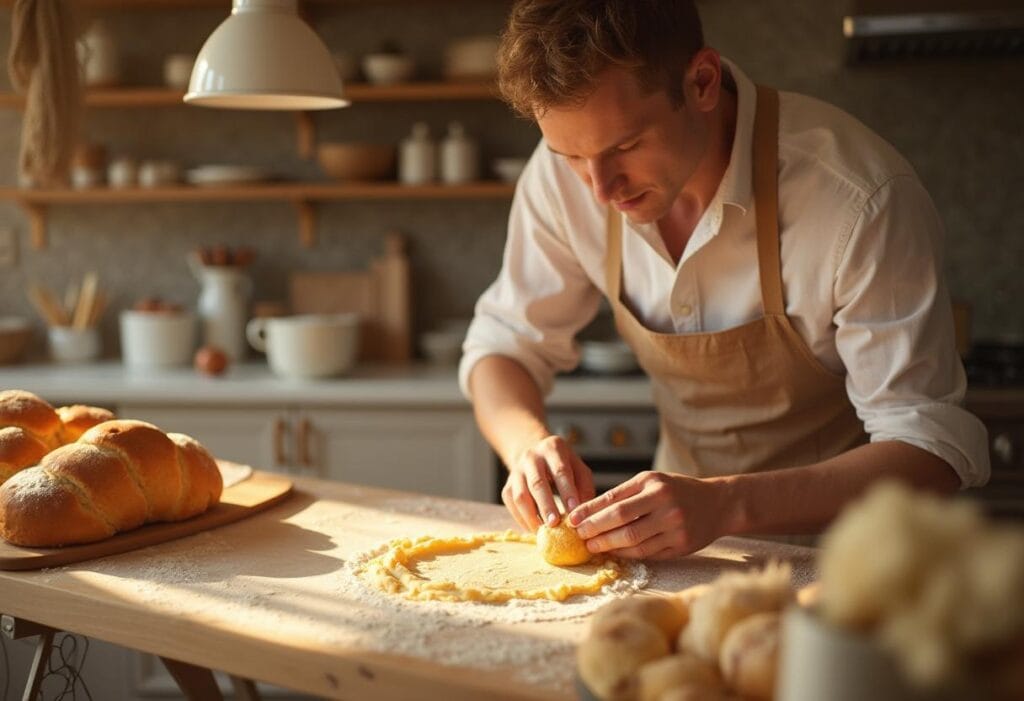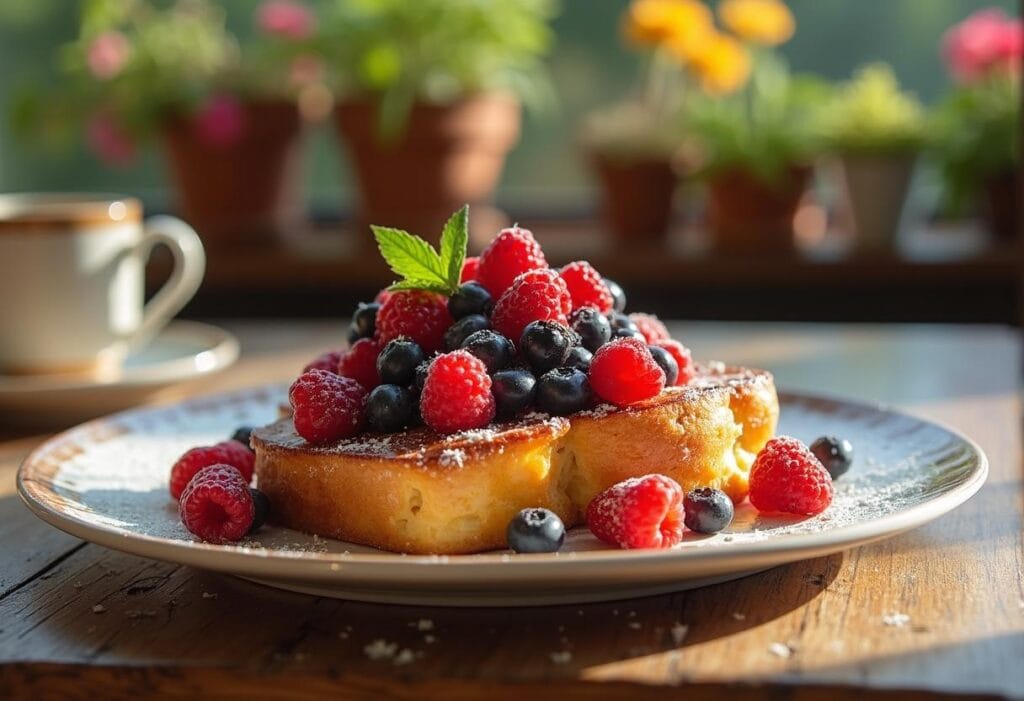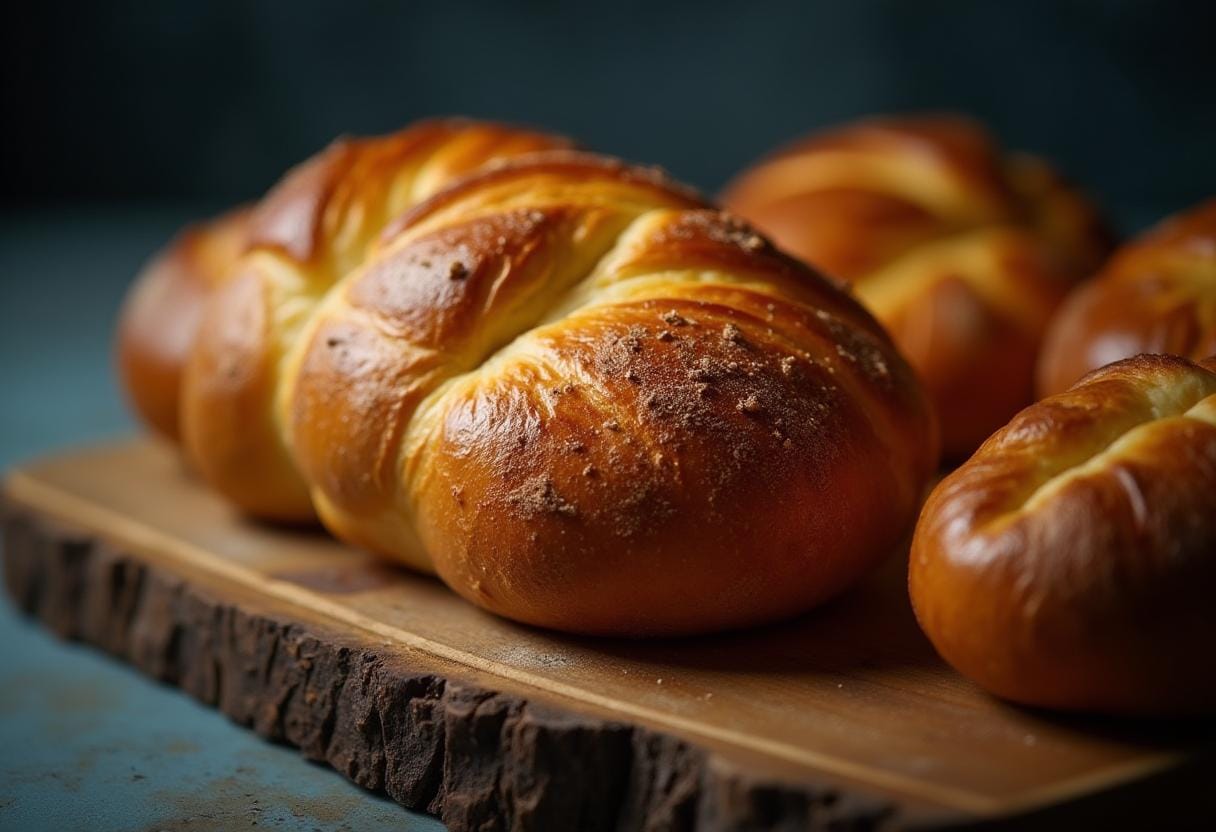What makes a brioche different from most breads It’s a question many bread lovers ask when they first experience its rich, buttery texture and delicate sweetness. Understanding what makes a brioche different from most breads is essential for both bakers and bread enthusiasts.
What makes a brioche different from most breads isn’t just a curiosity—it’s the key to using the right bread in every dish
Brioche is no ordinary bread—it’s an enriched dough made with butter, eggs, and sugar, setting it apart from simpler breads like baguettes or sandwich loaves. This luxurious combination gives brioche its signature soft crumb and versatility, making it a favorite for French toast, gourmet burgers, and decadent desserts.rioche adds an indulgent touch to any meal.
Unlike standard breads, which rely on water, flour, yeast, and salt, brioche is enriched with butter, eggs, and sugar. These additions turn what could be a humble bread into something akin to a pastry. The result is a rich, tender crumb that feels almost dessert-like.
“Brioche is what happens when bread takes a luxurious spa day—it’s pampered, indulgent, and oh-so-decadent.”
Brioche has a rich cultural heritage, particularly in France, where it’s enjoyed in many ways. Learn more about brioche traditions in France
The History of Brioche: What Makes a Brioche Different from Most Breads
Why Brioche Was Considered a Luxury Bread
When exploring what makes a brioche different from most breads, its origins in France are essential to understanding its unique qualities. Dating back to the 15th century, brioche was once considered a luxury item, reserved for special occasions. This indulgent bread became a global favorite, celebrated for its softness and rich flavor, qualities that highlight how brioche differs from regular bread.
Fast forward to today, and brioche has become a global favorite, celebrated for its versatility and flavor. Whether it’s used in French toast, gourmet burgers, or holiday bread puddings, brioche continues to charm bakers and diners alike. This enduring popularity further highlights wath brioche differs from regular bread.
How Brioche Became a Global Favorite: Why It Differs from Regular Bread
The versatility of brioche has helped it cross borders. Whether used in French toast, bread pudding, or as a gourmet burger bun, brioche adapts effortlessly to cuisines worldwide. Its slightly sweet, buttery flavor pairs beautifully with both sweet and savory dishes.
Key Ingredients That Explain What Makes Brioche Different from Most Breads
Understanding what makes a brioche different from most breads starts with its ingredients. While regular bread uses basic components, brioche takes things further with butter, eggs, and sugar. These enriched ingredients create a soft texture and a slightly sweet flavor, setting it apart from lean doughs like baguettes or sandwich loaves.
The ingredients clearly show what makes a brioche different from most breads, especially when compared to leaner doughs.
- Butter: Provides richness and a tender crumb.
- Eggs: Contribute to the bread’s structure and golden color.
- Sugar: Adds a subtle sweetness that complements both savory and sweet dishes.
These ingredients transform brioche into an enriched dough, giving it its signature flavor and texture. It’s no wonder that when asked « What makes brioche so special? », the answer always points to its luxurious composition.
The Importance of Eggs in Brioche Dough
Eggs are the backbone of brioche. They add structure, richness, and that golden-yellow hue we all recognize. The proteins in eggs also help create a tender, fluffy texture.
Butter and How It Makes Brioche Different from Regular Bread
Butter is what gives brioche its melt-in-your-mouth quality. Unlike lean breads, which focus on simplicity, brioche leans into indulgence. The butter makes the crumb softer and adds a luxurious richness.
Why Sugar Highlights What Makes Brioche Different from Most Breads
While not overly sweet, brioche includes sugar to enhance its flavor and support the yeast during fermentation. This subtle sweetness makes it versatile enough to complement both savory fillings and sugary glazes.
| Ingredient | Quantity in Brioche | Quantity in Regular Bread |
|---|---|---|
| Eggs | 3-5 per recipe | None |
| Butter | ½ to 1 cup | None |
| Sugar | 2-4 tbsp | 1 tsp or none |

The Science Behind Brioche: What Makes Its Dough Different from Most Breads
The process of making brioche highlights how brioche differs from regular bread. Its enriched dough contains butter and eggs, which slow gluten development and require longer proofing times. This slower process enhances the bread’s flavor and creates its tender crumb, key features of what makes brioche different from most breads.
Another distinguishing factor is the proofing process. Brioche dough requires more time to rise because the high fat content inhibits yeast activity. This slow rise allows the flavors to develop, making brioche even more delicious. When comparing brioche to regular bread, this slower, richer process is a defining feature.
Enriched Dough: What It Means
Enriched doughs are those that contain fat (like butter) and sugar, which inhibit gluten development. This makes the dough softer and more tender.
How Gluten Development Affects Brioche
While gluten gives bread structure, too much can make it chewy. Brioche strikes a balance by using gentle kneading and high-fat content to create a delicate crumb.
Another factor in what makes a brioche different from most breads is how gluten reacts differently in enriched doughs
The Role of Yeast in Achieving a Fluffy Texture
Yeast is the engine of brioche’s rise. However, the butter and sugar in brioche can slow down yeast activity, which is why brioche requires longer proofing times. This slow rise allows the flavors to deepen, resulting in a complex, buttery taste.
“Brioche dough is like a slow-cooking masterpiece—it takes its time, but the result is worth every minute.”

Brioche vs. Regular Bread: What Makes a Brioche Different from Most Breads
The ultimate question, « What makes a brioche different from most breads », comes down to ingredients, texture, and versatility.
If you’re comparing side-by-side, you’ll instantly see what makes a brioche different from most breads: richness, color, and flavor. Regular bread is firm, simple, and neutral, while brioche is soft, rich, and slightly sweet. These qualities make brioche ideal for gourmet dishes and indulgent recipes, unlike the everyday uses of regular bread.
Ingredients Comparison: Rich vs. Simple Dough
The primary difference lies in the ingredients. Regular bread uses the basics: flour, water, yeast, and salt. Brioche goes all out with butter, eggs, and sugar.
| Bread Type | Rich Ingredients | Lean Ingredients |
|---|---|---|
| Brioche | Butter, eggs, sugar | None |
| Regular Bread | None | Flour, water, yeast |
Texture and Flavor: Key Features That Make Brioche Different from Most Breads
Brioche has a soft, almost cake-like texture, while regular bread is firmer and chewier. The taste of brioche is subtly sweet and buttery, making it stand out even when eaten plain. Regular bread, on the other hand, is more neutral, allowing it to pair with a wide variety of flavors.
A Comparison of Ingredients: What Makes Brioche Stand Out Among Breads
Brioche is often associated with indulgence, making it a popular choice for special dishes like:
- French Toast: Its richness absorbs the custard beautifully.
- Burger Buns: The slight sweetness balances the savory patty.
- Sweet Rolls: Add cinnamon or chocolate for a decadent treat.
Part 1 Summary
We’ve explored the unique qualities that make brioche stand apart from most breads, diving into its rich history, luxurious ingredients, and scientific foundation. Ready to learn more? In the next part, we’ll tackle common problems when making brioche, explore variations, and share how you can use brioche in your cooking adventures. Stay tuned! 😊
Common Problems That Illustrate What Makes a Brioche Different from Most Breads
f you’ve tried baking brioche at home, you’ve likely encountered challenges that highlight what makes brioche different from most breads. Its enriched dough is stickier and more delicate to handle than regular bread dough, but the result is a bread with unmatched richness and flavor.
Why Brioche Dough Is Trickier Than Regular Bread Dough
The high butter and egg content in brioche dough naturally makes it stickier than regular bread dough. If your dough feels impossible to work with, don’t panic!
Solution:
- Chill the dough for 30 minutes before handling it. The cold butter will firm up, making the dough easier to knead and shape.
- Use a stand mixer with a dough hook to reduce the mess and effort.
What Causes Dense Brioche?
Dense brioche is often the result of under-kneading or under-proofing. Both steps are essential to create the light, airy texture brioche is known for.
Solution:
- Knead the dough until it passes the “windowpane test” (stretch a small piece of dough; it should form a thin, translucent sheet without tearing).
- Allow the dough to rise fully during both proofing stages. Patience is key!
How to Prevent Overbaking Brioche
Brioche bakes quickly due to its high fat and sugar content. Overbaking can lead to a dry texture and burnt crust.
Solution:
- Keep an eye on the brioche during the last 5 minutes of baking. A golden brown color and an internal temperature of 190°F (88°C) are your indicators of doneness.
- If the top browns too quickly, cover it with aluminum foil to prevent burning.
Popular Variations of Brioche Around the World
One of the joys of brioche is its adaptability. Different cultures have put their own spin on this rich bread, creating delicious variations that cater to local tastes.
Sweet Brioche Variations
- Brioche Tressée: A braided version of brioche, often topped with pearl sugar for added sweetness.
- Chocolate Chip Brioche: Incorporates chunks of chocolate into the dough, making it perfect for dessert.
- Fruit-Stuffed Brioche: Filled with seasonal fruits like apples, berries, or apricots for a fruity twist.
Savory Brioche Innovations
Brioche isn’t just for sweets! Add savory ingredients to create a whole new experience:
- Cheese-Stuffed Brioche: A gooey, cheesy center adds a burst of flavor.
- Herbed Brioche: Incorporate fresh rosemary, thyme, or parsley for a fragrant loaf.
- Brioche Sliders: Mini brioche buns filled with savory fillings like pulled pork or grilled veggies.
Regional Twists on Brioche Recipes
Around the world, brioche has taken on new identities:
- Panettone (Italy): A sweet, fruit-filled bread often served during Christmas.
- Kugelhopf (Austria): A brioche-style bread baked in a Bundt pan with raisins and nuts.
- Babka (Eastern Europe): While slightly different, babka shares brioche’s enriched dough characteristics and is often swirled with chocolate or cinnamon.
How to Use Brioche in Your Cooking
Brioche’s versatility makes it a favorite in both sweet and savory recipes. Here are some creative ways to use brioche in your cooking:
Brioche as a Base for Gourmet Burgers and Sandwiches
Gourmet burgers and sandwiches are taken to the next level with brioche buns. The slightly sweet, buttery flavor contrasts beautifully with savory fillings like beef patties, roasted vegetables, or even crispy fried chicken.
Sweet Treats Made with Brioche
- Brioche French Toast: The richness of brioche absorbs custard beautifully, resulting in a soft, flavorful breakfast dish.
- Bread Pudding: Leftover brioche makes a decadent pudding, especially when combined with cream, sugar, and your favorite spices.
- Brioche Donuts: Fry brioche dough into donuts for a fluffy, indulgent treat.
Brioche in Breakfast and Brunch Dishes
Brioche is a brunch superstar! Use it for:
- Eggs Benedict: Swap the English muffin for a toasted brioche slice.
- Breakfast Sandwiches: Layer eggs, bacon, and cheese between brioche halves.
- Jam Toast: A simple yet satisfying way to enjoy brioche with your favorite jam or marmalade.
The Art of Making Brioche: Mastering the Process
Baking brioche isn’t just about following a recipe; it’s about understanding the process. The magic of brioche lies in its transformation from a sticky dough into a golden, buttery masterpiece.
Why Patience is Key in Brioche Baking
Brioche dough requires long proofing times due to its enriched nature. The high fat and sugar content slow down yeast activity, meaning it takes longer for the dough to rise. But don’t rush it—good things come to those who wait!
Here’s why patience pays off:
- Enhanced Flavor: A slow rise allows the yeast to develop complex flavors, giving brioche its signature taste.
- Better Texture: Proper proofing ensures a light, airy crumb instead of a dense loaf.
Chilling the Dough: A Pro Tip
Because brioche dough is so rich, it can be tricky to handle. Chilling the dough after the first rise firms up the butter, making it easier to shape without sticking.
Serving Suggestions: What Makes Brioche Perfect for Any Meal
From breakfast to dessert, brioche’s versatility showcases what makes a brioche different from most breads. Whether you’re making French toast, gourmet burgers, or bread pudding, brioche elevates every dish with its buttery texture and slightly sweet flavor.

Breakfast and Brunch
- Classic Toast: Toasted brioche with butter and honey or jam is a simple yet luxurious way to start the day.
- Stuffed French Toast: Fill brioche slices with cream cheese and fruit before dipping them in custard and frying.
- Breakfast Sliders: Use mini brioche buns to make sliders with scrambled eggs, sausage, and cheese.
Lunch and Dinner
- Gourmet Sandwiches: Think smoked salmon with cream cheese and capers or roasted vegetables with hummus on brioche slices.
- Soup Companion: Pair a crusty brioche loaf with creamy soups like tomato bisque or pumpkin soup for a cozy meal.
- Burger Buns: Elevate your burgers with brioche buns. The soft, slightly sweet bread balances savory patties perfectly.
Desserts
- Brioche Bread Pudding: Combine torn brioche pieces with custard, bake, and top with caramel sauce.
- Nutella-Stuffed Brioche: Shape brioche dough into rolls with a dollop of Nutella inside, then bake and dust with powdered sugar.
- Fruit Brioche Tart: Use brioche as a base for a fruit tart topped with custard and fresh berries.
“Brioche is like the Swiss Army knife of bread—it can adapt to any meal and make it better!”
The Healthier Side of Brioche: Is It Possible?
Brioche is known for being indulgent, but is it possible to make a healthier version without losing its signature appeal? Absolutely! Here are some ways to tweak the recipe:
Using Whole Wheat Flour
Substitute part of the all-purpose flour with whole wheat flour for added fiber and nutrients. The texture will be slightly denser, but the rich flavor will remain.
Replacing Sugar
Swap out white sugar for natural sweeteners like honey, maple syrup, or coconut sugar. These options not only reduce refined sugar but also add unique flavors.
Lowering the Fat Content
Instead of using all butter, try a mix of butter and Greek yogurt. This cuts down on fat while still providing richness.
Portion Control
Since brioche is so rich, smaller portions can go a long way. Consider making mini brioche buns or rolls to satisfy cravings without overindulging.
Interesting Facts About Brioche
Did you know? Brioche has some fascinating history and quirks that make it even more special.
- Marie Antoinette Myth: The famous phrase “Let them eat cake” is often misattributed to Marie Antoinette and believed to reference brioche. However, historians say she likely never said it!
- Perfect Pairing: Brioche pairs exceptionally well with sparkling wines and champagne because its subtle sweetness balances the acidity of the drinks.
- A Royal Bread: In France, brioche was once considered a luxury item fit for royalty due to its expensive ingredients.
Expanding Your Brioche Repertoire
If you’ve mastered classic brioche, why stop there? Here are a few advanced techniques and recipes to try:
Brioche Feuilletée (Laminated Brioche)
This version combines the richness of brioche with the flakiness of puff pastry. It’s a labor-intensive process that involves folding and layering butter into the dough, but the results are worth it.
Brioche Crown (Couronne)
Shape your brioche into a circular crown, often topped with almonds and pearl sugar. This festive version is perfect for celebrations.
Savory Brioche Rings
Incorporate fillings like sautéed mushrooms, spinach, and cheese into your brioche dough, then shape it into a ring before baking.
“Once you start experimenting with brioche, the possibilities are endless—it’s a playground for your culinary creativity!”
FAQs About What Makes Brioche Different
Why is brioche considered an enriched bread?
Because it contains butter, eggs, and sugar—ingredients that add richness and set it apart from lean breads.
What makes brioche different from most breads in texture?
Its crumb is soft and cake-like, unlike the firm and chewy texture of regular bread.
Is brioche sweeter than regular bread?
Yes, brioche has a slight sweetness from added sugar, making it versatile for sweet and savory recipes.
Is Brioche Healthier or Less Healthy Than Other Breads?
Brioche is richer in fat and sugar than regular bread, making it less healthy in terms of calories. However, it’s perfect for occasional indulgence and special occasions.
Can I Substitute Brioche for Other Bread?
Yes! Brioche works well as a substitute for regular bread in recipes like sandwiches, French toast, and bread pudding. Just be aware that its sweetness might alter the flavor slightly.
Why Is Brioche Considered a Special Occasion Bread?
Historically, brioche was reserved for special occasions due to its expensive ingredients. Today, it’s still seen as a luxurious treat perfect for holidays and celebrations.
How Long Does Brioche Stay Fresh?
Brioche stays fresh for 1-2 days at room temperature. For longer storage, freeze it and reheat as needed.
What Makes Brioche Dough Different from Regular Dough
Brioche dough is enriched with butter, eggs, and sugar, creating a softer, richer bread compared to lean doughs made with just flour, water, yeast, and salt.
What makes a brioche different from most breads in terms of preparation?
Brioche requires longer proofing times and careful temperature control due to its high fat content. The enriched dough is also more delicate to handle than traditional bread dough, requiring special techniques for optimal results
Conclusion: Why Brioche Is a Bread Like No Other
Brioche isn’t just bread—it’s an experience. What makes a brioche different from most breads—its buttery richness, delicate crumb, and versatility—make it a favorite for bakers and food lovers alike. Whether you’re indulging in a sweet variation or using it to elevate a savory dish, brioche has a way of turning ordinary meals into extraordinary ones.
“If regular bread is the everyday hero, brioche is the star of the show—luxurious, elegant, and unforgettable.”
Now that you fully understand what makes a brioche different from most breads, you’re ready to experiment with confidence.
So, why not try making brioche at home? With patience and the tips shared here, you’ll master this unique bread in no time. Your kitchen will thank you with the sweet, buttery aroma of fresh brioche. 😊

